Structural Analysis 1 Assignment: Truss Force & Beam Deflection Calc
VerifiedAdded on 2023/06/03
|12
|1576
|450
Homework Assignment
AI Summary
This assignment solution covers fundamental concepts in structural analysis, focusing on determining forces in truss members and calculating deflections in beams. The first question involves analyzing a truss structure to find the forces in each member, identifying whether they are in tension or compression, using methods of joints. The second question deals with calculating the deflection of a beam under given loading conditions, including uniformly distributed loads and point loads. The solution utilizes integration methods to derive the deflection equation, considering boundary conditions to determine constants of integration. Numerical results for deflection at specific points, such as the midspan and free ends, are calculated and presented. This document is available on Desklib, a platform that provides students with access to past papers and solved assignments.
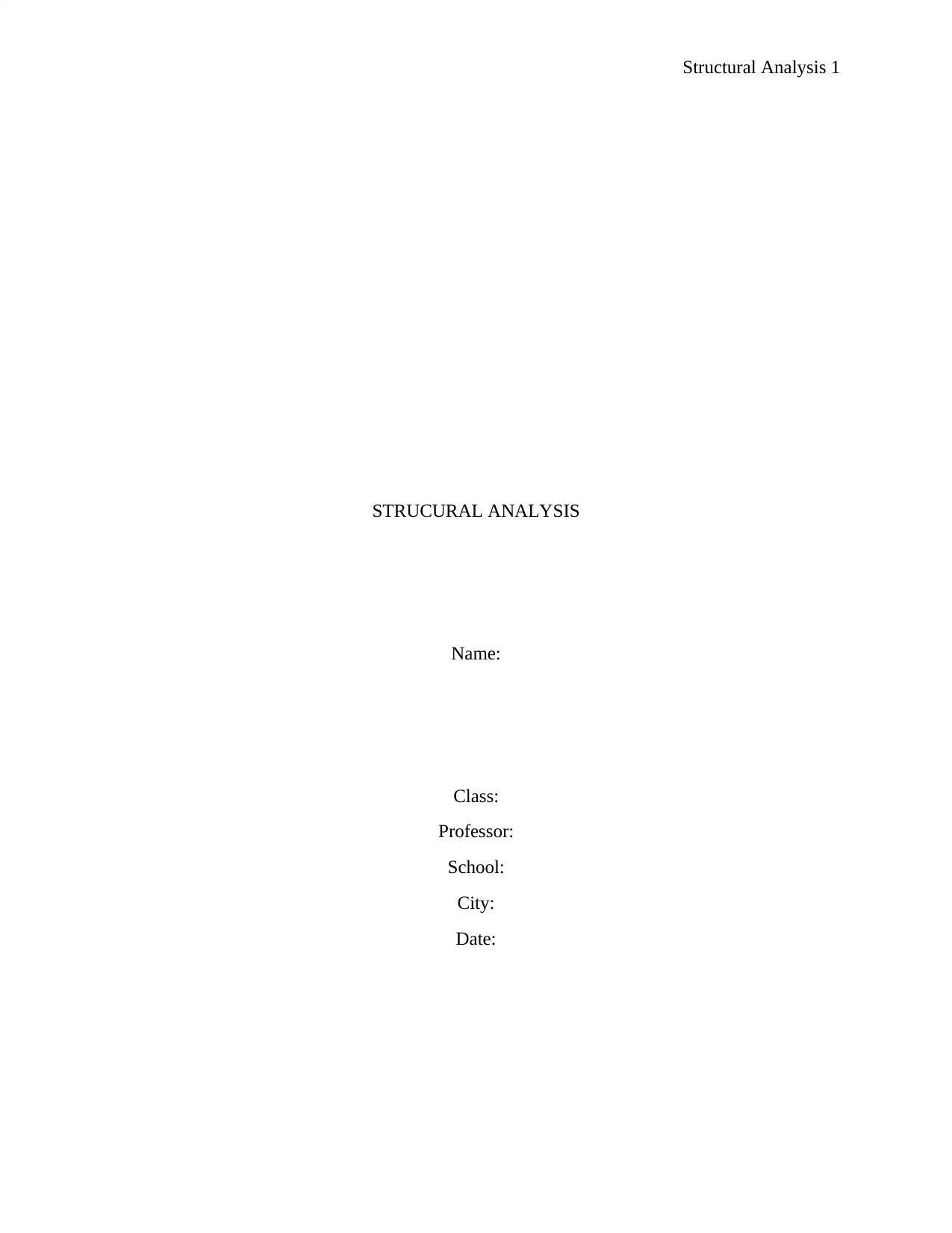
Structural Analysis 1
STRUCURAL ANALYSIS
Name:
Class:
Professor:
School:
City:
Date:
STRUCURAL ANALYSIS
Name:
Class:
Professor:
School:
City:
Date:
Paraphrase This Document
Need a fresh take? Get an instant paraphrase of this document with our AI Paraphraser
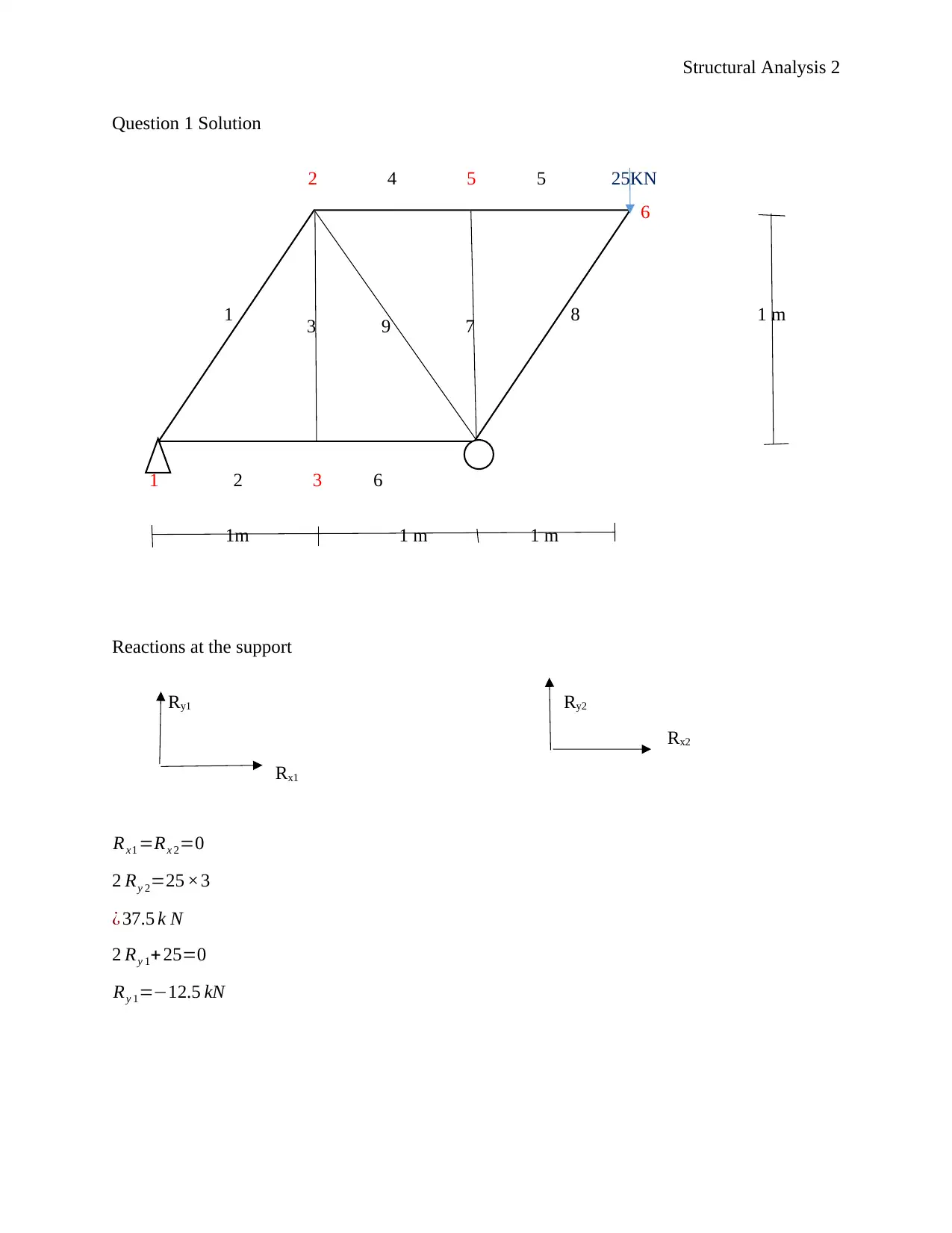
Structural Analysis 2
Question 1 Solution
2 4 5 5 25KN
6
1 8 1 m
1 2 3 6
1m 1 m 1 m
Reactions at the support
Ry1 Ry2
Rx2
Rx1
Rx1 =Rx 2=0
2 Ry 2=25 ×3
¿ 37.5 k N
2 Ry 1+ 25=0
Ry 1=−12.5 kN
3 9 7
Question 1 Solution
2 4 5 5 25KN
6
1 8 1 m
1 2 3 6
1m 1 m 1 m
Reactions at the support
Ry1 Ry2
Rx2
Rx1
Rx1 =Rx 2=0
2 Ry 2=25 ×3
¿ 37.5 k N
2 Ry 1+ 25=0
Ry 1=−12.5 kN
3 9 7
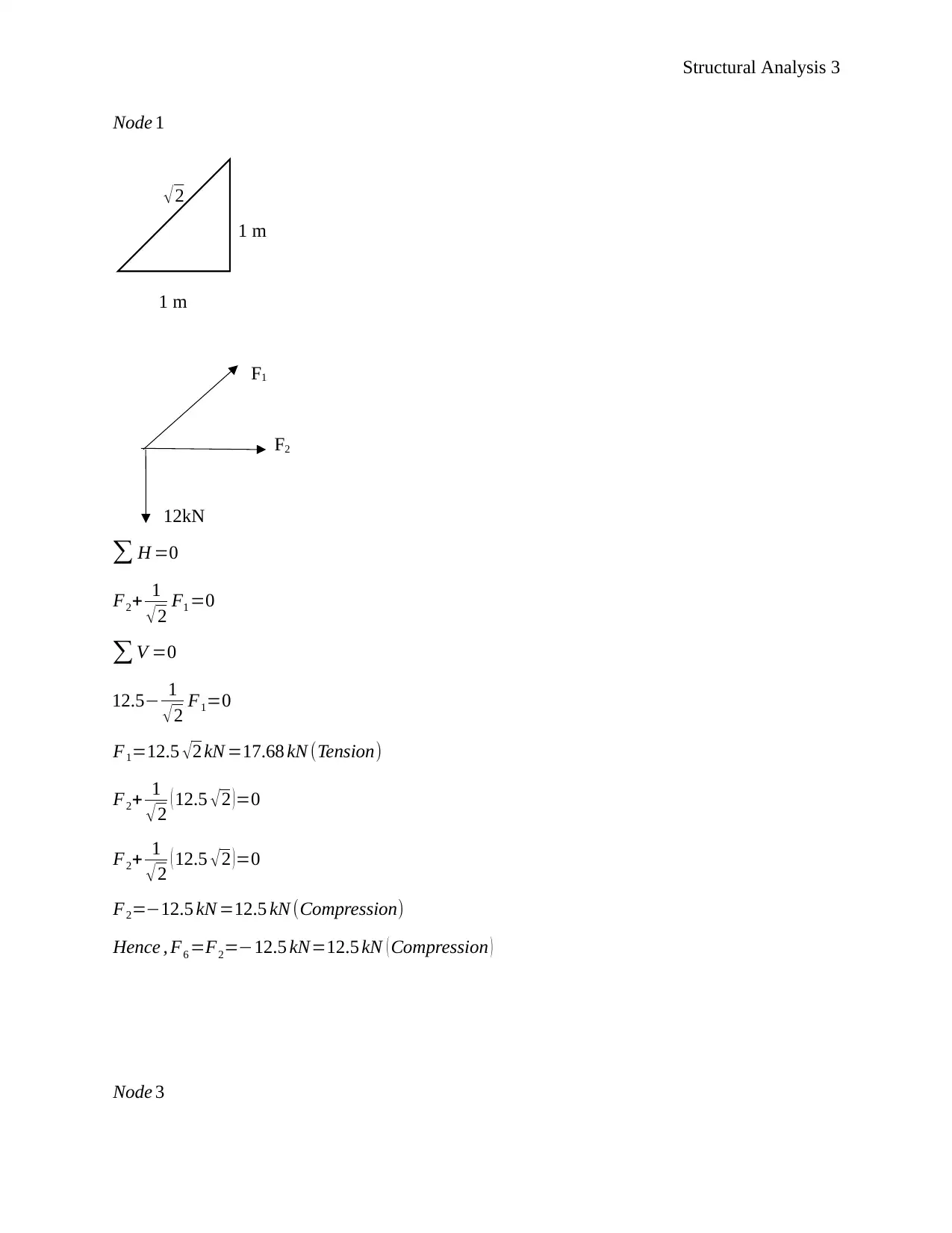
Structural Analysis 3
Node 1
√2
1 m
1 m
F1
F2
12kN
∑ H =0
F2+ 1
√ 2 F1 =0
∑ V =0
12.5− 1
√ 2 F1=0
F1=12.5 √2 kN =17.68 kN (Tension)
F2+ 1
√ 2 ( 12.5 √2 )=0
F2+ 1
√ 2 ( 12.5 √2 )=0
F2=−12.5 kN =12.5 kN (Compression)
Hence , F6 =F2=−12.5 kN=12.5 kN ( Compression )
Node 3
Node 1
√2
1 m
1 m
F1
F2
12kN
∑ H =0
F2+ 1
√ 2 F1 =0
∑ V =0
12.5− 1
√ 2 F1=0
F1=12.5 √2 kN =17.68 kN (Tension)
F2+ 1
√ 2 ( 12.5 √2 )=0
F2+ 1
√ 2 ( 12.5 √2 )=0
F2=−12.5 kN =12.5 kN (Compression)
Hence , F6 =F2=−12.5 kN=12.5 kN ( Compression )
Node 3
⊘ This is a preview!⊘
Do you want full access?
Subscribe today to unlock all pages.

Trusted by 1+ million students worldwide
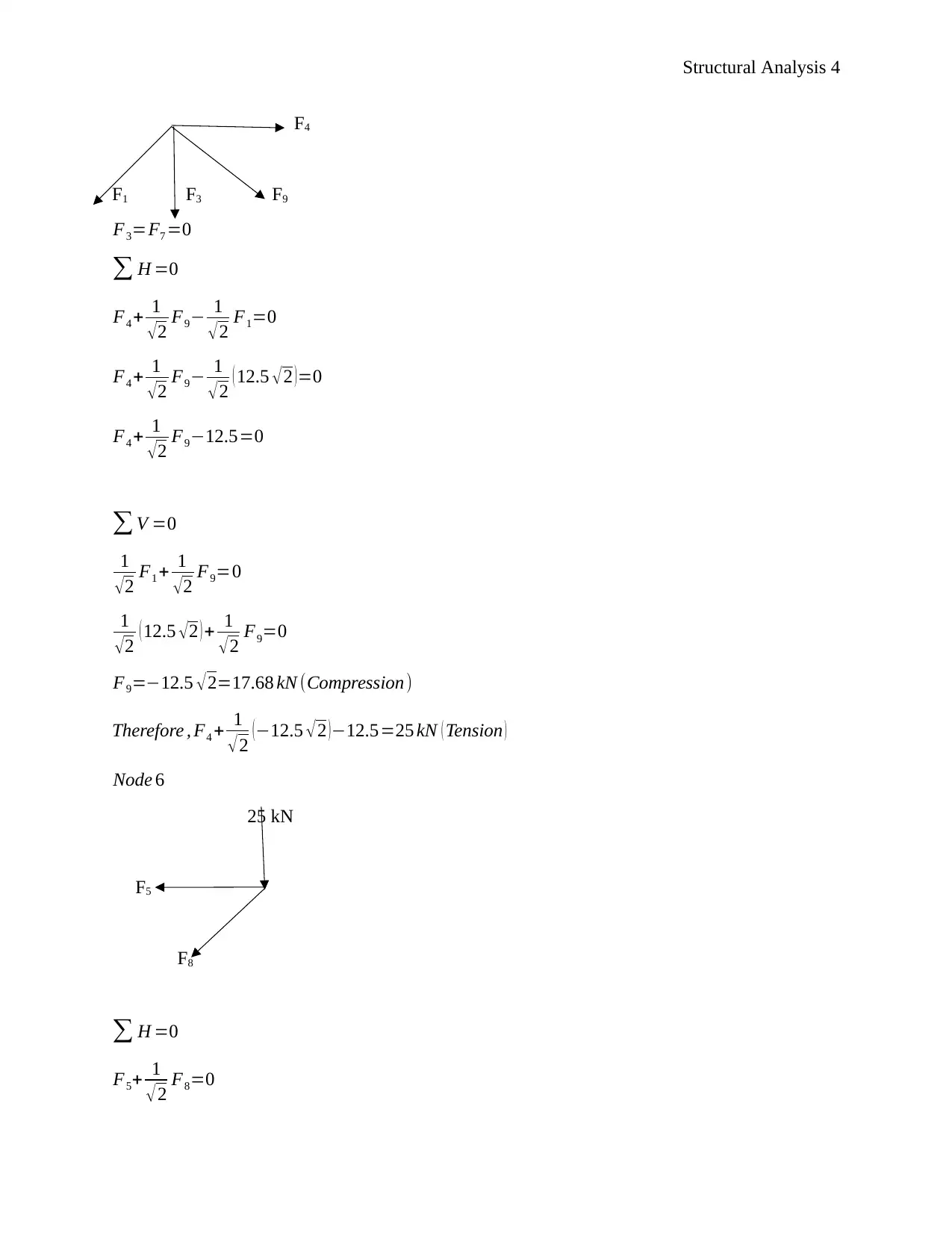
Structural Analysis 4
F4
F1 F3 F9
F3=F7 =0
∑ H =0
F4 + 1
√2 F9− 1
√2 F1=0
F4 + 1
√2 F9− 1
√2 ( 12.5 √2 )=0
F4 + 1
√2 F9−12.5=0
∑ V =0
1
√2 F1 + 1
√2 F9=0
1
√2 ( 12.5 √2 ) + 1
√2 F9=0
F9=−12.5 √ 2=17.68 kN (Compression)
Therefore , F4 + 1
√ 2 (−12.5 √2 )−12.5=25 kN ( Tension )
Node 6
25 kN
F5
F8
∑ H =0
F5+ 1
√ 2 F8=0
F4
F1 F3 F9
F3=F7 =0
∑ H =0
F4 + 1
√2 F9− 1
√2 F1=0
F4 + 1
√2 F9− 1
√2 ( 12.5 √2 )=0
F4 + 1
√2 F9−12.5=0
∑ V =0
1
√2 F1 + 1
√2 F9=0
1
√2 ( 12.5 √2 ) + 1
√2 F9=0
F9=−12.5 √ 2=17.68 kN (Compression)
Therefore , F4 + 1
√ 2 (−12.5 √2 )−12.5=25 kN ( Tension )
Node 6
25 kN
F5
F8
∑ H =0
F5+ 1
√ 2 F8=0
Paraphrase This Document
Need a fresh take? Get an instant paraphrase of this document with our AI Paraphraser
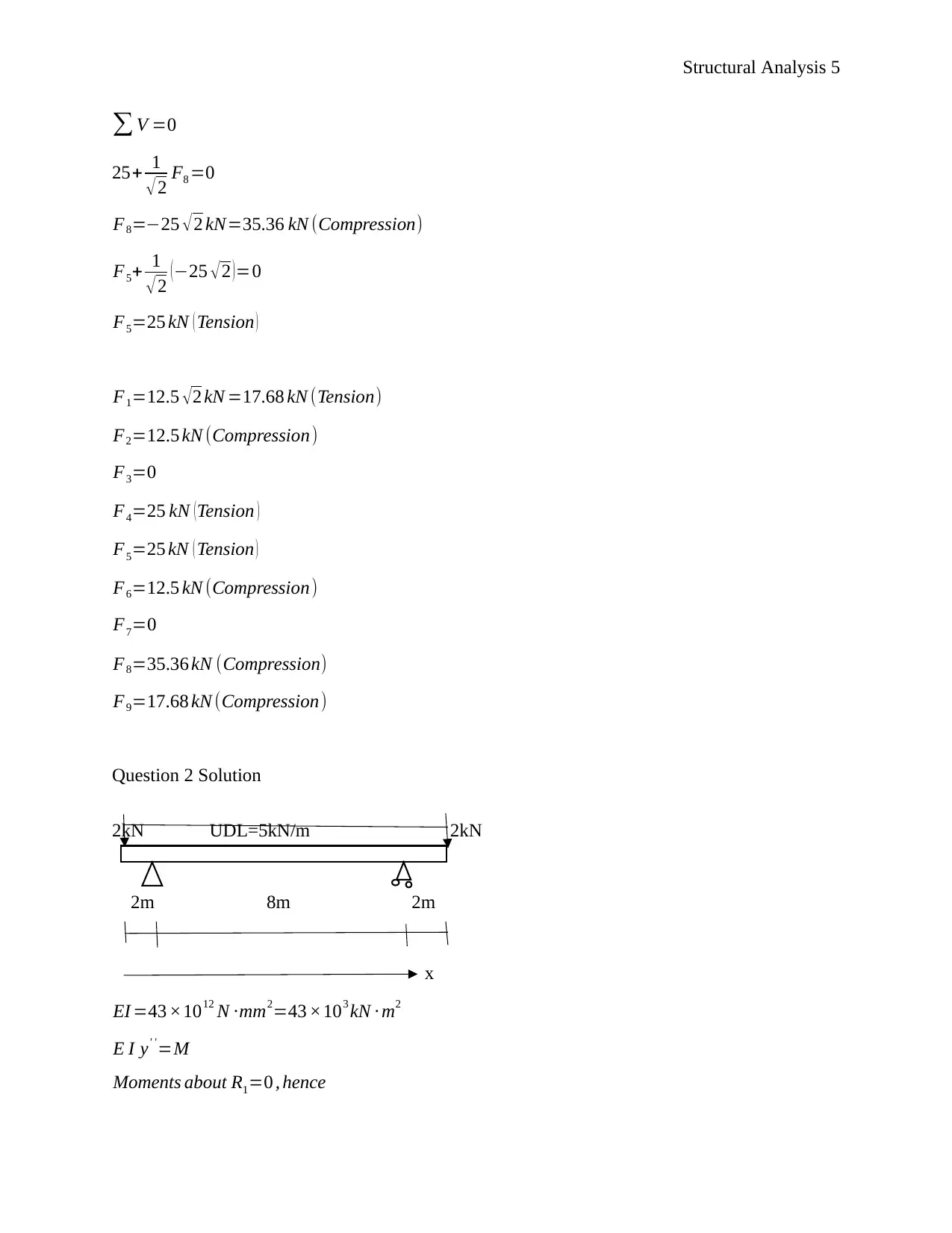
Structural Analysis 5
∑ V =0
25+ 1
√ 2 F8 =0
F8=−25 √ 2 kN=35.36 kN (Compression)
F5+ 1
√ 2 (−25 √2 )=0
F5=25 kN ( Tension )
F1=12.5 √ 2 kN =17.68 kN (Tension)
F2=12.5 kN (Compression)
F3=0
F4=25 kN (Tension )
F5=25 kN ( Tension )
F6=12.5 kN (Compression)
F7=0
F8=35.36 kN (Compression)
F9=17.68 kN (Compression)
Question 2 Solution
2kN UDL=5kN/m 2kN
2m 8m 2m
x
EI =43 ×1012 N ∙mm2=43 ×103 kN ∙ m2
E I y' ' =M
Moments about R1=0 , hence
∑ V =0
25+ 1
√ 2 F8 =0
F8=−25 √ 2 kN=35.36 kN (Compression)
F5+ 1
√ 2 (−25 √2 )=0
F5=25 kN ( Tension )
F1=12.5 √ 2 kN =17.68 kN (Tension)
F2=12.5 kN (Compression)
F3=0
F4=25 kN (Tension )
F5=25 kN ( Tension )
F6=12.5 kN (Compression)
F7=0
F8=35.36 kN (Compression)
F9=17.68 kN (Compression)
Question 2 Solution
2kN UDL=5kN/m 2kN
2m 8m 2m
x
EI =43 ×1012 N ∙mm2=43 ×103 kN ∙ m2
E I y' ' =M
Moments about R1=0 , hence
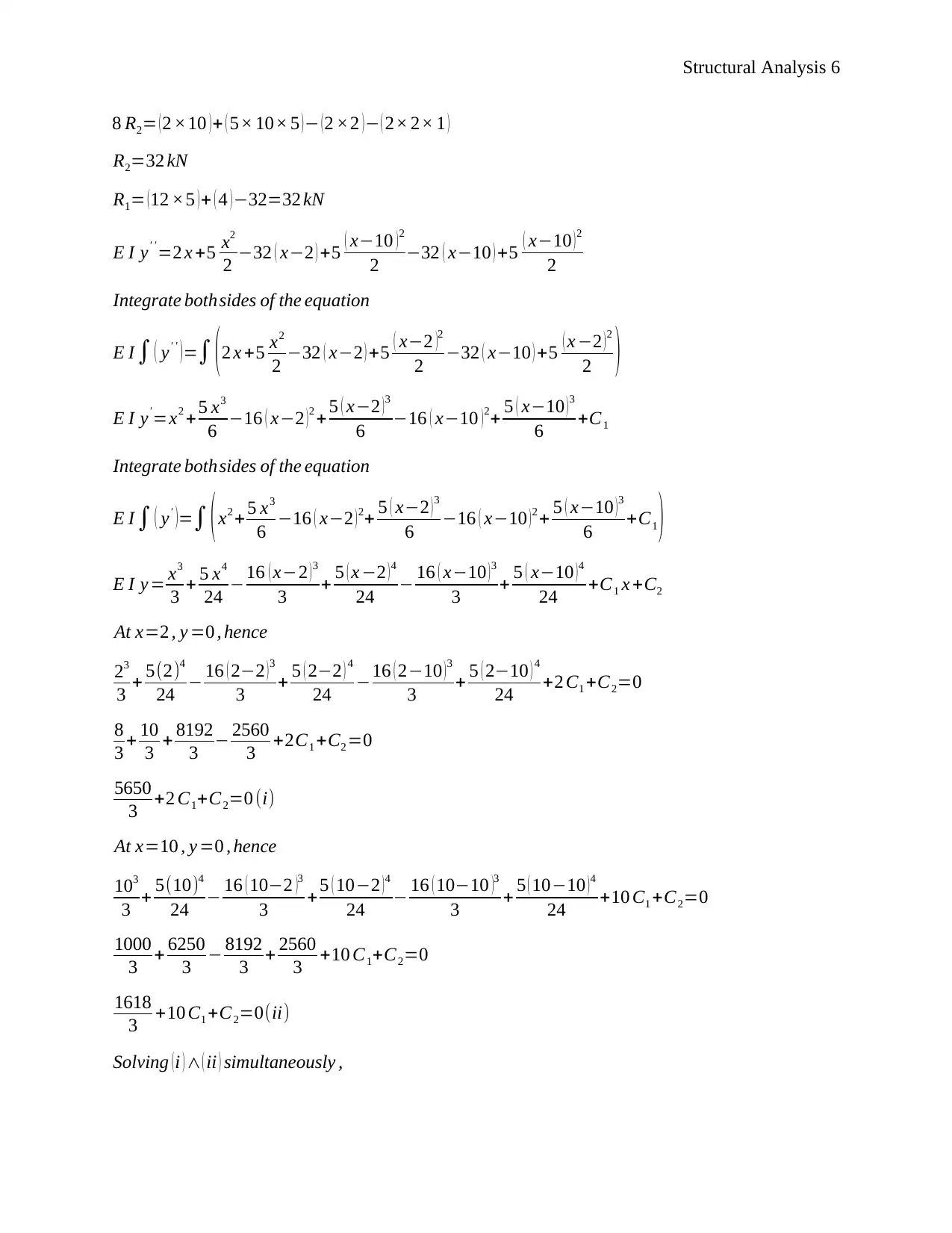
Structural Analysis 6
8 R2= (2 ×10 )+ ( 5× 10× 5 )− (2 ×2 )− ( 2× 2× 1 )
R2=32 kN
R1= (12 ×5 )+ ( 4 )−32=32 kN
E I y' ' =2 x +5 x2
2 −32 ( x−2 ) +5 ( x−10 ) 2
2 −32 ( x−10 ) +5 ( x−10 ) 2
2
Integrate bothsides of the equation
E I ∫ ( y' ' ) =∫ ( 2 x +5 x2
2 −32 ( x−2 ) +5 ( x−2 )2
2 −32 ( x−10 ) +5 ( x −2 ) 2
2 )
E I y'=x2 + 5 x3
6 −16 ( x−2 ) 2 + 5 ( x−2 ) 3
6 −16 ( x−10 ) 2+ 5 ( x−10 ) 3
6 +C1
Integrate bothsides of the equation
E I ∫ ( y' )=∫ ( x2 + 5 x3
6 −16 ( x−2 ) 2+ 5 ( x−2 ) 3
6 −16 ( x−10 ) 2 + 5 ( x−10 ) 3
6 +C1 )
E I y = x3
3 + 5 x4
24 −16 ( x−2 ) 3
3 + 5 ( x −2 ) 4
24 − 16 ( x−10 ) 3
3 + 5 ( x−10 ) 4
24 +C1 x +C2
At x=2 , y =0 , hence
23
3 + 5(2)4
24 − 16 ( 2−2 ) 3
3 + 5 ( 2−2 ) 4
24 −16 ( 2−10 ) 3
3 + 5 ( 2−10 ) 4
24 +2 C1 +C2=0
8
3 + 10
3 + 8192
3 − 2560
3 +2C1 +C2 =0
5650
3 +2 C1+C2=0 (i)
At x=10 , y =0 , hence
103
3 + 5(10)4
24 − 16 ( 10−2 )3
3 + 5 ( 10−2 ) 4
24 − 16 ( 10−10 )3
3 + 5 ( 10−10 ) 4
24 +10 C1 +C2=0
1000
3 + 6250
3 − 8192
3 + 2560
3 +10 C1+C2=0
1618
3 +10 C1 +C2=0(ii)
Solving (i ) ∧ ( ii ) simultaneously ,
8 R2= (2 ×10 )+ ( 5× 10× 5 )− (2 ×2 )− ( 2× 2× 1 )
R2=32 kN
R1= (12 ×5 )+ ( 4 )−32=32 kN
E I y' ' =2 x +5 x2
2 −32 ( x−2 ) +5 ( x−10 ) 2
2 −32 ( x−10 ) +5 ( x−10 ) 2
2
Integrate bothsides of the equation
E I ∫ ( y' ' ) =∫ ( 2 x +5 x2
2 −32 ( x−2 ) +5 ( x−2 )2
2 −32 ( x−10 ) +5 ( x −2 ) 2
2 )
E I y'=x2 + 5 x3
6 −16 ( x−2 ) 2 + 5 ( x−2 ) 3
6 −16 ( x−10 ) 2+ 5 ( x−10 ) 3
6 +C1
Integrate bothsides of the equation
E I ∫ ( y' )=∫ ( x2 + 5 x3
6 −16 ( x−2 ) 2+ 5 ( x−2 ) 3
6 −16 ( x−10 ) 2 + 5 ( x−10 ) 3
6 +C1 )
E I y = x3
3 + 5 x4
24 −16 ( x−2 ) 3
3 + 5 ( x −2 ) 4
24 − 16 ( x−10 ) 3
3 + 5 ( x−10 ) 4
24 +C1 x +C2
At x=2 , y =0 , hence
23
3 + 5(2)4
24 − 16 ( 2−2 ) 3
3 + 5 ( 2−2 ) 4
24 −16 ( 2−10 ) 3
3 + 5 ( 2−10 ) 4
24 +2 C1 +C2=0
8
3 + 10
3 + 8192
3 − 2560
3 +2C1 +C2 =0
5650
3 +2 C1+C2=0 (i)
At x=10 , y =0 , hence
103
3 + 5(10)4
24 − 16 ( 10−2 )3
3 + 5 ( 10−2 ) 4
24 − 16 ( 10−10 )3
3 + 5 ( 10−10 ) 4
24 +10 C1 +C2=0
1000
3 + 6250
3 − 8192
3 + 2560
3 +10 C1+C2=0
1618
3 +10 C1 +C2=0(ii)
Solving (i ) ∧ ( ii ) simultaneously ,
⊘ This is a preview!⊘
Do you want full access?
Subscribe today to unlock all pages.

Trusted by 1+ million students worldwide
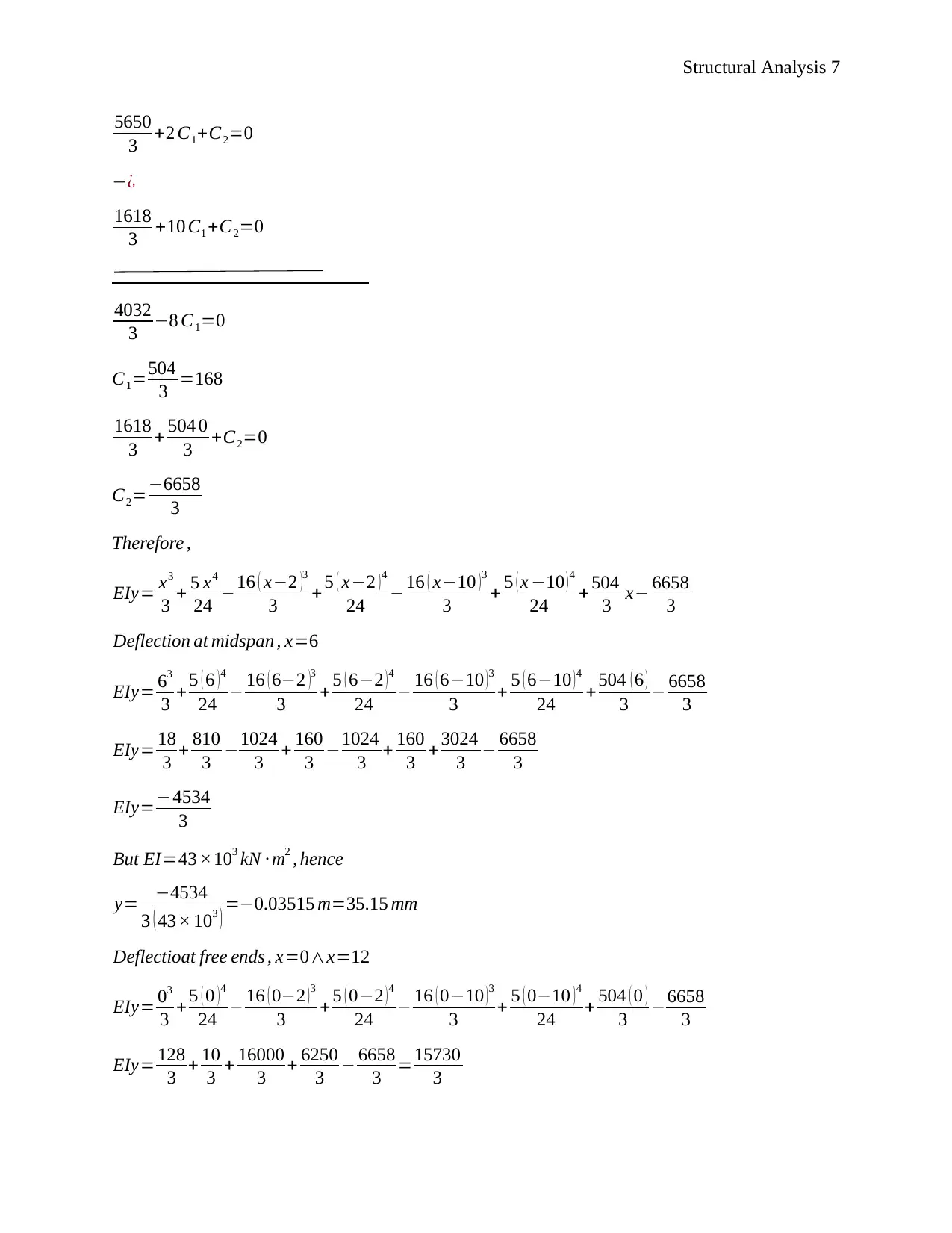
Structural Analysis 7
5650
3 +2 C1+C2=0
−¿
1618
3 +10 C1 +C2=0
4032
3 −8 C1=0
C1=504
3 =168
1618
3 + 504 0
3 +C2=0
C2=−6658
3
Therefore ,
EIy= x3
3 + 5 x4
24 −16 ( x−2 )3
3 + 5 ( x−2 )4
24 −16 ( x−10 )3
3 + 5 ( x −10 )4
24 + 504
3 x− 6658
3
Deflection at midspan , x=6
EIy= 63
3 + 5 ( 6 ) 4
24 − 16 ( 6−2 )3
3 + 5 ( 6−2 ) 4
24 − 16 ( 6−10 ) 3
3 + 5 ( 6−10 ) 4
24 + 504 ( 6 )
3 − 6658
3
EIy= 18
3 + 810
3 −1024
3 + 160
3 −1024
3 + 160
3 + 3024
3 − 6658
3
EIy=−4534
3
But EI=43 ×103 kN ∙ m2 , hence
y= −4534
3 ( 43 × 103 ) =−0.03515 m=35.15 mm
Deflectioat free ends , x=0∧x=12
EIy= 03
3 + 5 ( 0 ) 4
24 − 16 ( 0−2 ) 3
3 + 5 ( 0−2 ) 4
24 − 16 ( 0−10 ) 3
3 + 5 ( 0−10 ) 4
24 + 504 ( 0 )
3 −6658
3
EIy= 128
3 + 10
3 + 16000
3 + 6250
3 − 6658
3 =15730
3
5650
3 +2 C1+C2=0
−¿
1618
3 +10 C1 +C2=0
4032
3 −8 C1=0
C1=504
3 =168
1618
3 + 504 0
3 +C2=0
C2=−6658
3
Therefore ,
EIy= x3
3 + 5 x4
24 −16 ( x−2 )3
3 + 5 ( x−2 )4
24 −16 ( x−10 )3
3 + 5 ( x −10 )4
24 + 504
3 x− 6658
3
Deflection at midspan , x=6
EIy= 63
3 + 5 ( 6 ) 4
24 − 16 ( 6−2 )3
3 + 5 ( 6−2 ) 4
24 − 16 ( 6−10 ) 3
3 + 5 ( 6−10 ) 4
24 + 504 ( 6 )
3 − 6658
3
EIy= 18
3 + 810
3 −1024
3 + 160
3 −1024
3 + 160
3 + 3024
3 − 6658
3
EIy=−4534
3
But EI=43 ×103 kN ∙ m2 , hence
y= −4534
3 ( 43 × 103 ) =−0.03515 m=35.15 mm
Deflectioat free ends , x=0∧x=12
EIy= 03
3 + 5 ( 0 ) 4
24 − 16 ( 0−2 ) 3
3 + 5 ( 0−2 ) 4
24 − 16 ( 0−10 ) 3
3 + 5 ( 0−10 ) 4
24 + 504 ( 0 )
3 −6658
3
EIy= 128
3 + 10
3 + 16000
3 + 6250
3 − 6658
3 =15730
3
Paraphrase This Document
Need a fresh take? Get an instant paraphrase of this document with our AI Paraphraser
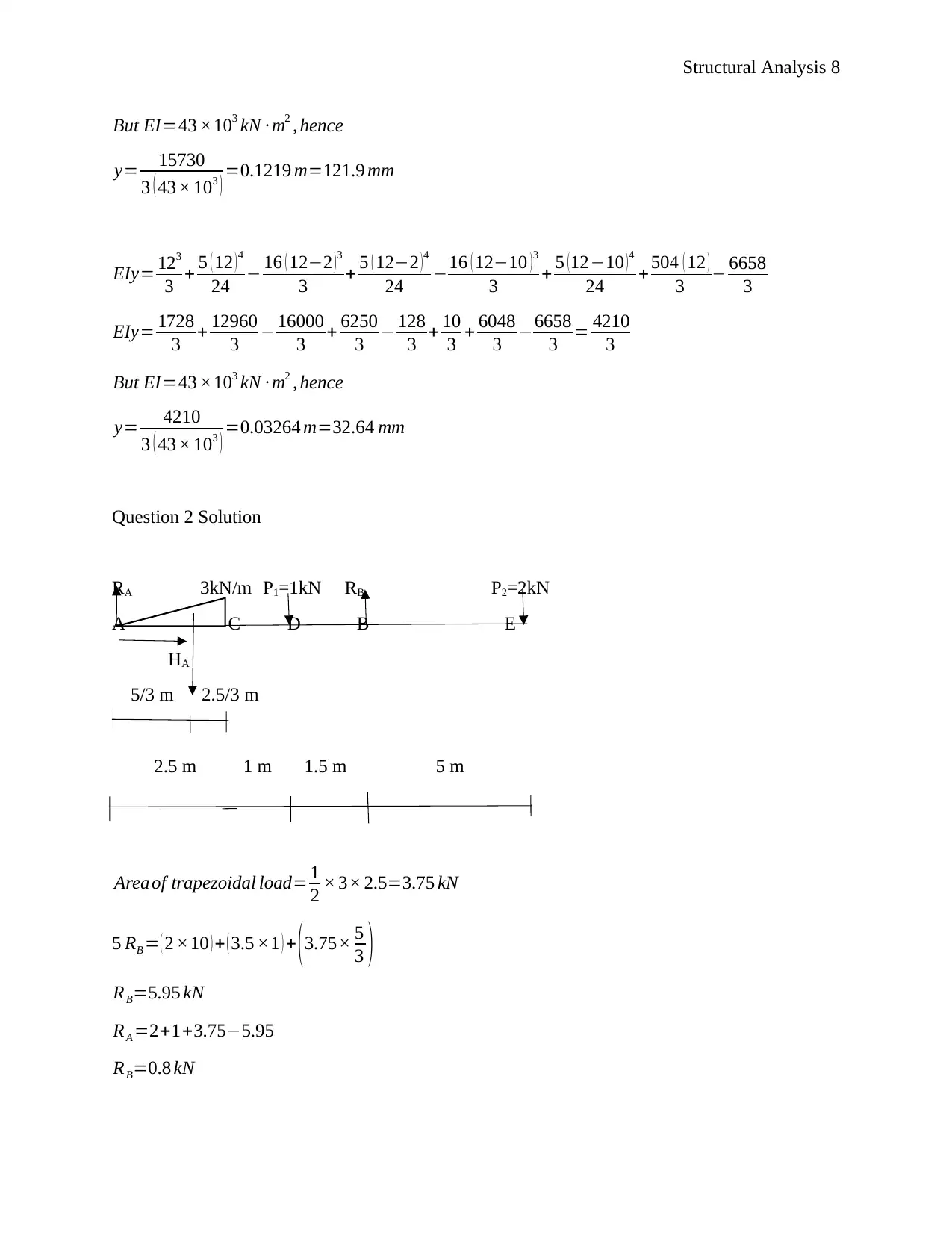
Structural Analysis 8
But EI=43 ×103 kN ∙ m2 , hence
y= 15730
3 ( 43 × 103 ) =0.1219 m=121.9 mm
EIy= 123
3 + 5 ( 12 ) 4
24 − 16 ( 12−2 ) 3
3 + 5 ( 12−2 ) 4
24 −16 ( 12−10 ) 3
3 + 5 ( 12−10 ) 4
24 + 504 ( 12 )
3 − 6658
3
EIy= 1728
3 + 12960
3 − 16000
3 + 6250
3 − 128
3 + 10
3 + 6048
3 −6658
3 = 4210
3
But EI=43 ×103 kN ∙ m2 , hence
y= 4210
3 ( 43 × 103 ) =0.03264 m=32.64 mm
Question 2 Solution
RA 3kN/m P1=1kN RB P2=2kN
A C D B E
HA
5/3 m 2.5/3 m
2.5 m 1 m 1.5 m 5 m
Area of trapezoidal load= 1
2 × 3× 2.5=3.75 kN
5 RB = ( 2 ×10 ) + ( 3.5 ×1 ) + (3.75× 5
3 )
RB=5.95 kN
RA =2+1+3.75−5.95
RB=0.8 kN
But EI=43 ×103 kN ∙ m2 , hence
y= 15730
3 ( 43 × 103 ) =0.1219 m=121.9 mm
EIy= 123
3 + 5 ( 12 ) 4
24 − 16 ( 12−2 ) 3
3 + 5 ( 12−2 ) 4
24 −16 ( 12−10 ) 3
3 + 5 ( 12−10 ) 4
24 + 504 ( 12 )
3 − 6658
3
EIy= 1728
3 + 12960
3 − 16000
3 + 6250
3 − 128
3 + 10
3 + 6048
3 −6658
3 = 4210
3
But EI=43 ×103 kN ∙ m2 , hence
y= 4210
3 ( 43 × 103 ) =0.03264 m=32.64 mm
Question 2 Solution
RA 3kN/m P1=1kN RB P2=2kN
A C D B E
HA
5/3 m 2.5/3 m
2.5 m 1 m 1.5 m 5 m
Area of trapezoidal load= 1
2 × 3× 2.5=3.75 kN
5 RB = ( 2 ×10 ) + ( 3.5 ×1 ) + (3.75× 5
3 )
RB=5.95 kN
RA =2+1+3.75−5.95
RB=0.8 kN
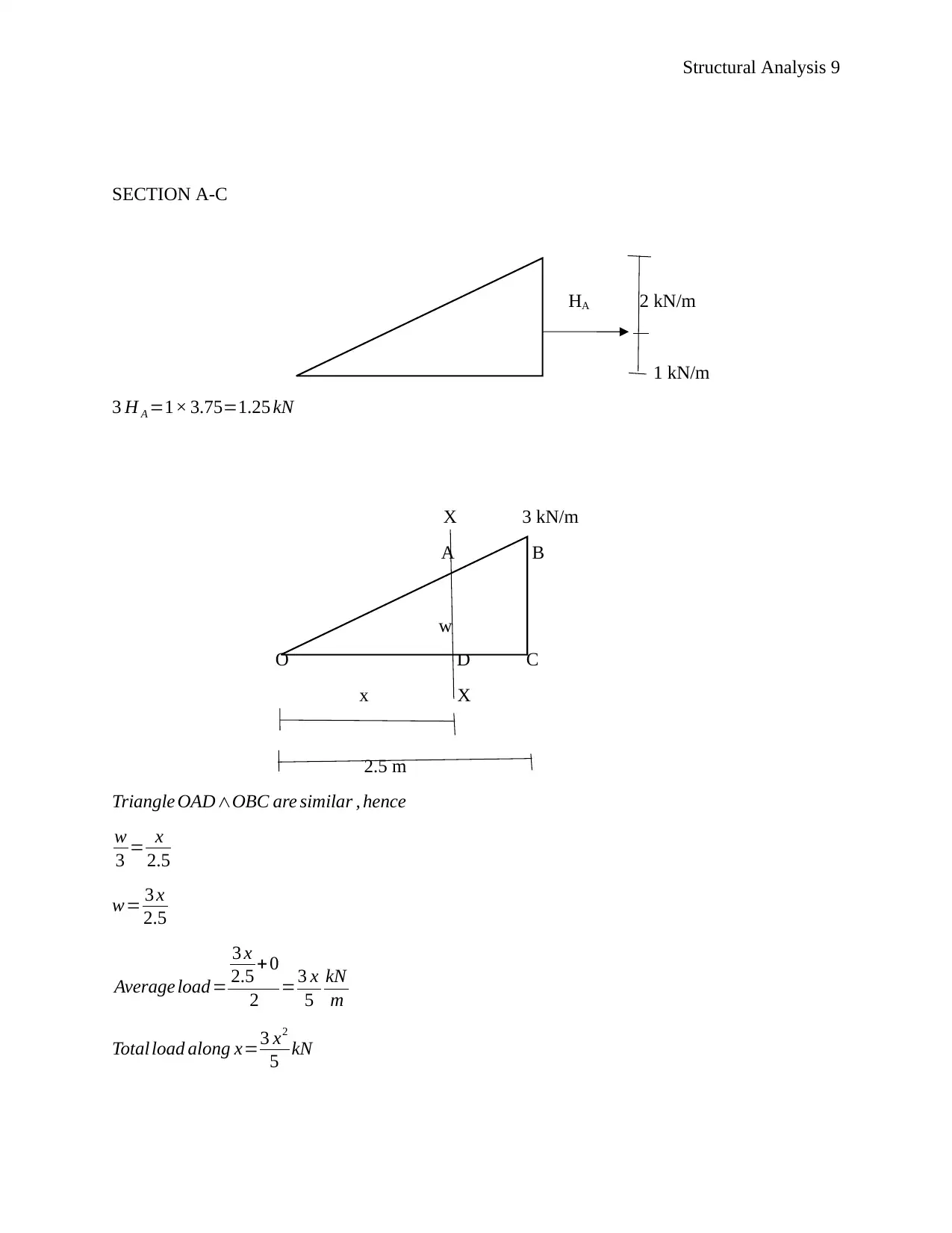
Structural Analysis 9
SECTION A-C
HA 2 kN/m
1 kN/m
3 H A =1× 3.75=1.25 kN
X 3 kN/m
A B
W
O D C
x X
2.5 m
Triangle OAD∧OBC are similar , hence
w
3 = x
2.5
w= 3 x
2.5
Average load=
3 x
2.5 + 0
2 =3 x
5
kN
m
Total load along x=3 x2
5 kN
w
SECTION A-C
HA 2 kN/m
1 kN/m
3 H A =1× 3.75=1.25 kN
X 3 kN/m
A B
W
O D C
x X
2.5 m
Triangle OAD∧OBC are similar , hence
w
3 = x
2.5
w= 3 x
2.5
Average load=
3 x
2.5 + 0
2 =3 x
5
kN
m
Total load along x=3 x2
5 kN
w
⊘ This is a preview!⊘
Do you want full access?
Subscribe today to unlock all pages.

Trusted by 1+ million students worldwide
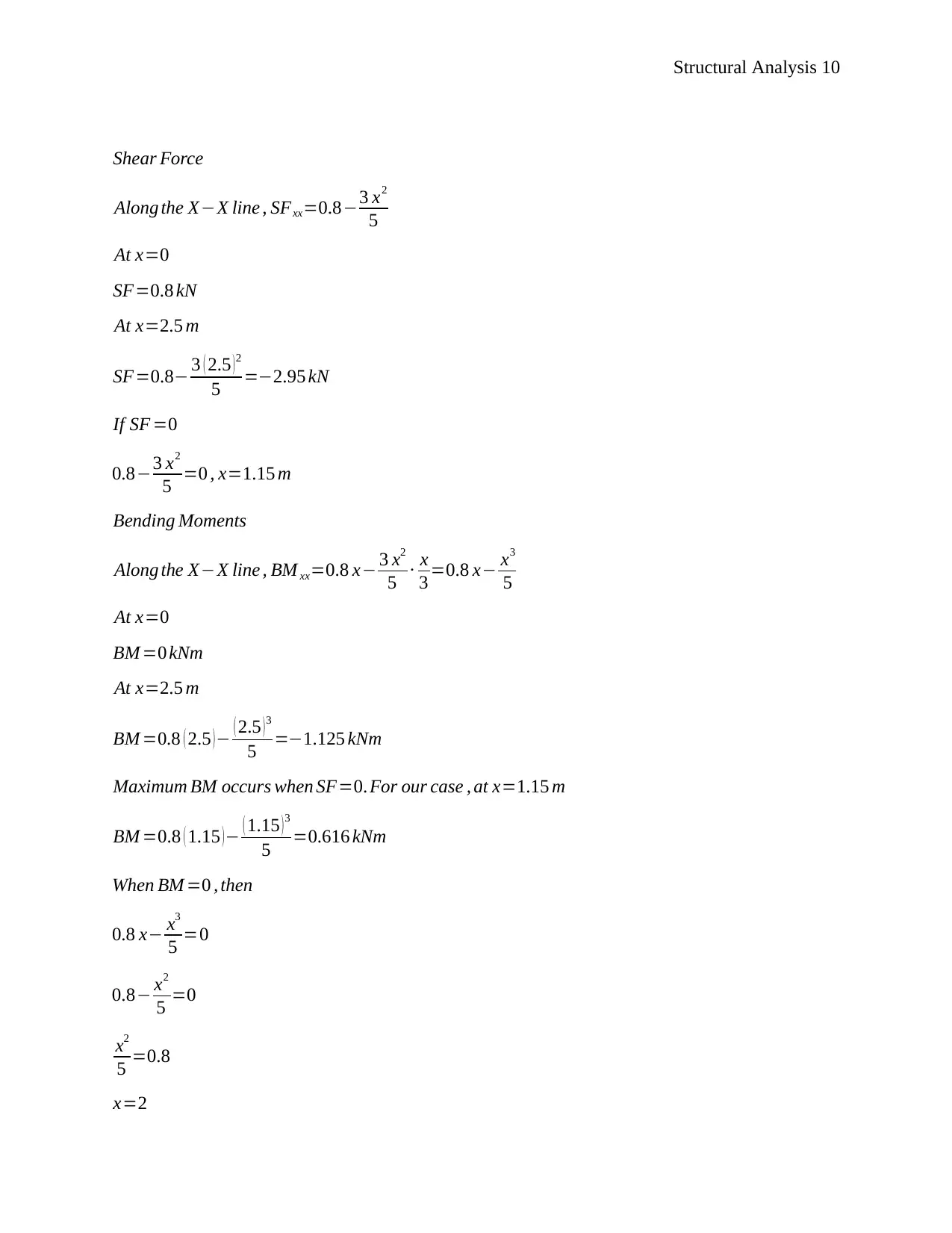
Structural Analysis 10
Shear Force
Along the X−X line , SFxx=0.8−3 x2
5
At x=0
SF=0.8 kN
At x=2.5 m
SF=0.8− 3 ( 2.5 ) 2
5 =−2.95 kN
If SF =0
0.8−3 x2
5 =0 , x=1.15 m
Bending Moments
Along the X−X line , BM xx=0.8 x− 3 x2
5 ∙ x
3 =0.8 x− x3
5
At x=0
BM =0 kNm
At x=2.5 m
BM =0.8 ( 2.5 ) − ( 2.5 ) 3
5 =−1.125 kNm
Maximum BM occurs when SF=0. For our case , at x=1.15 m
BM =0.8 ( 1.15 )− ( 1.15 )3
5 =0.616 kNm
When BM =0 , then
0.8 x− x3
5 =0
0.8− x2
5 =0
x2
5 =0.8
x=2
Shear Force
Along the X−X line , SFxx=0.8−3 x2
5
At x=0
SF=0.8 kN
At x=2.5 m
SF=0.8− 3 ( 2.5 ) 2
5 =−2.95 kN
If SF =0
0.8−3 x2
5 =0 , x=1.15 m
Bending Moments
Along the X−X line , BM xx=0.8 x− 3 x2
5 ∙ x
3 =0.8 x− x3
5
At x=0
BM =0 kNm
At x=2.5 m
BM =0.8 ( 2.5 ) − ( 2.5 ) 3
5 =−1.125 kNm
Maximum BM occurs when SF=0. For our case , at x=1.15 m
BM =0.8 ( 1.15 )− ( 1.15 )3
5 =0.616 kNm
When BM =0 , then
0.8 x− x3
5 =0
0.8− x2
5 =0
x2
5 =0.8
x=2
Paraphrase This Document
Need a fresh take? Get an instant paraphrase of this document with our AI Paraphraser
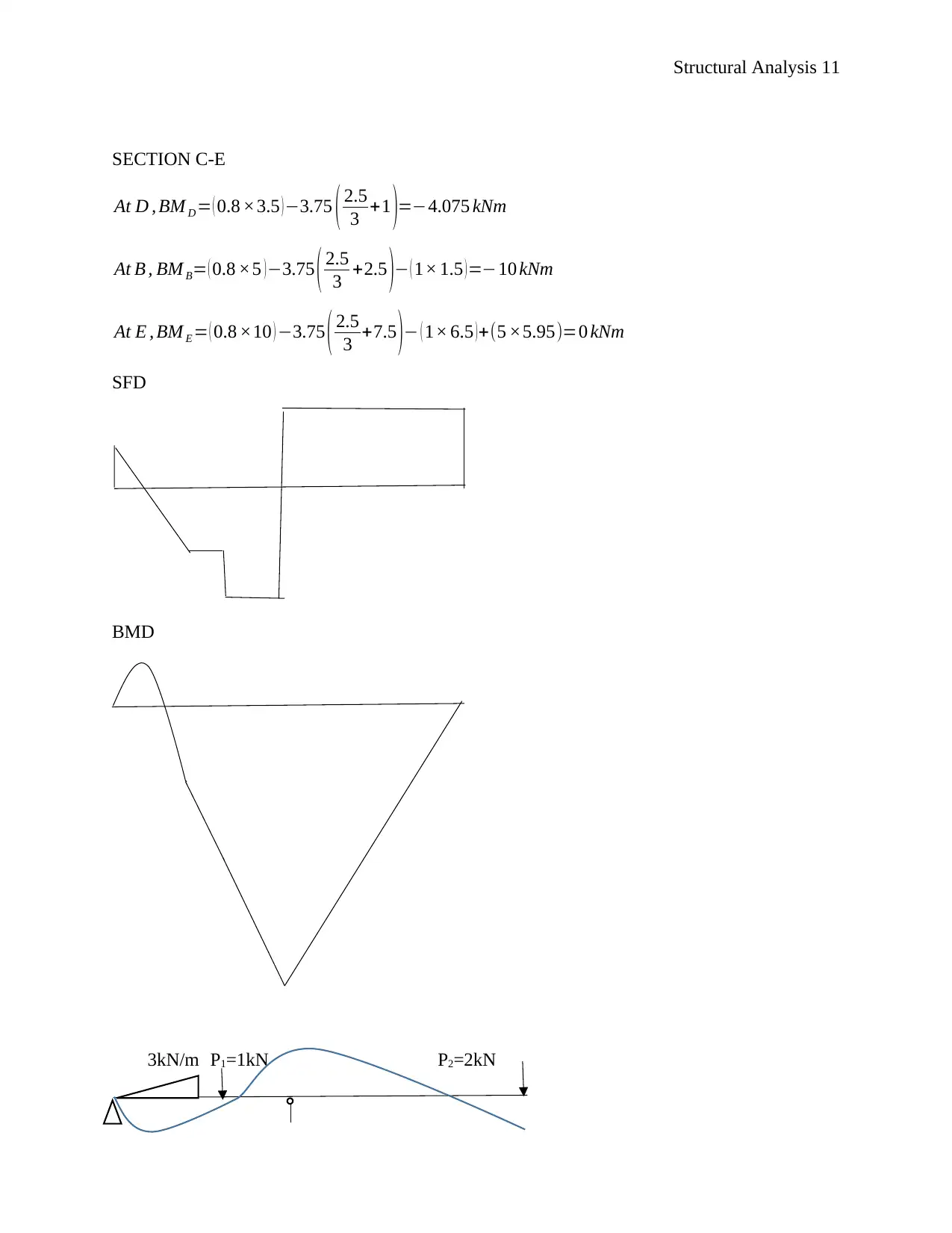
Structural Analysis 11
SECTION C-E
At D , BM D= ( 0.8 ×3.5 )−3.75 ( 2.5
3 +1 )=−4.075 kNm
At B , BM B= ( 0.8 ×5 )−3.75 ( 2.5
3 +2.5 )− ( 1× 1.5 )=−10 kNm
At E , BM E = ( 0.8 ×10 ) −3.75 ( 2.5
3 +7.5 )− ( 1× 6.5 )+(5 ×5.95)=0 kNm
SFD
BMD
3kN/m P1=1kN P2=2kN
SECTION C-E
At D , BM D= ( 0.8 ×3.5 )−3.75 ( 2.5
3 +1 )=−4.075 kNm
At B , BM B= ( 0.8 ×5 )−3.75 ( 2.5
3 +2.5 )− ( 1× 1.5 )=−10 kNm
At E , BM E = ( 0.8 ×10 ) −3.75 ( 2.5
3 +7.5 )− ( 1× 6.5 )+(5 ×5.95)=0 kNm
SFD
BMD
3kN/m P1=1kN P2=2kN
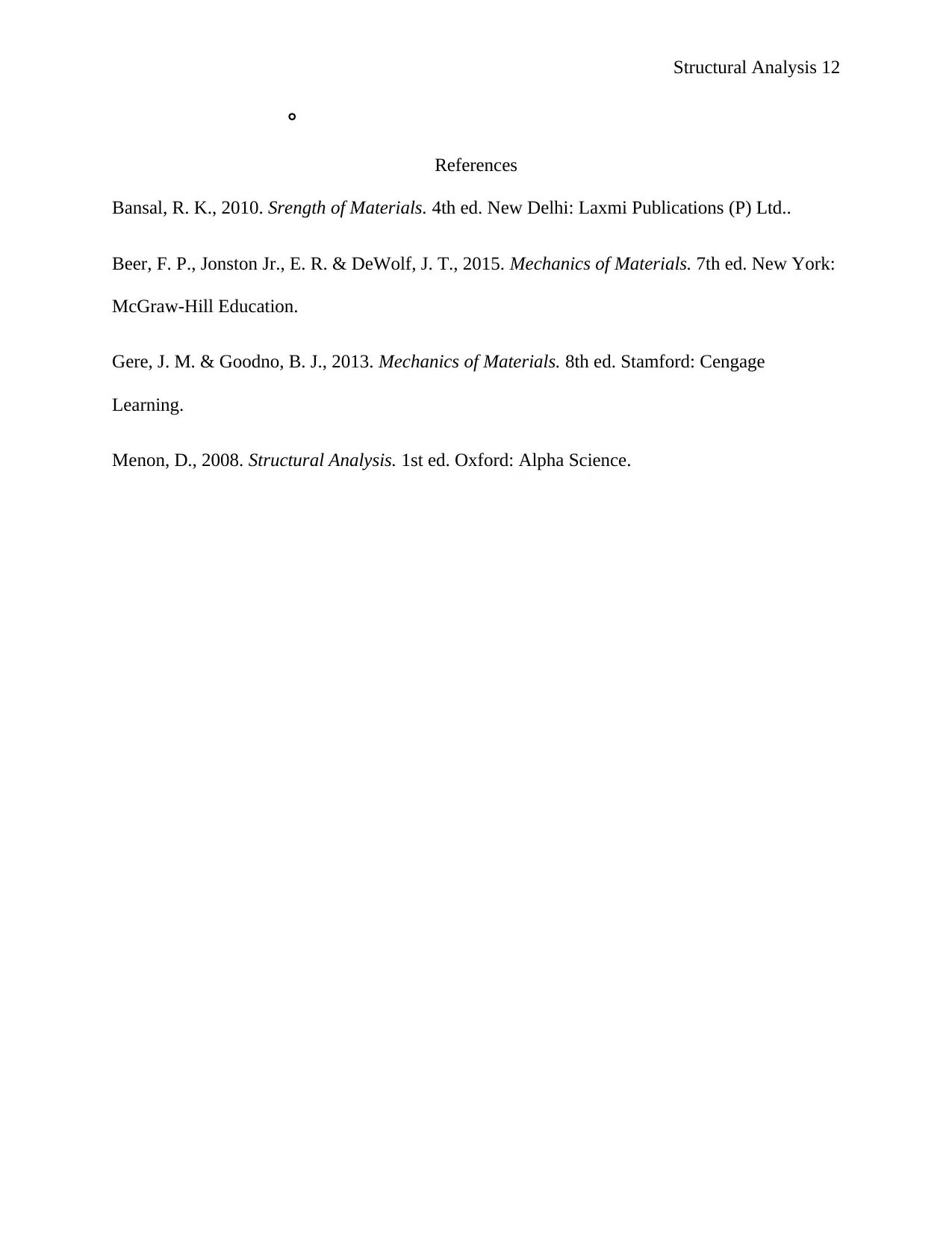
Structural Analysis 12
References
Bansal, R. K., 2010. Srength of Materials. 4th ed. New Delhi: Laxmi Publications (P) Ltd..
Beer, F. P., Jonston Jr., E. R. & DeWolf, J. T., 2015. Mechanics of Materials. 7th ed. New York:
McGraw-Hill Education.
Gere, J. M. & Goodno, B. J., 2013. Mechanics of Materials. 8th ed. Stamford: Cengage
Learning.
Menon, D., 2008. Structural Analysis. 1st ed. Oxford: Alpha Science.
References
Bansal, R. K., 2010. Srength of Materials. 4th ed. New Delhi: Laxmi Publications (P) Ltd..
Beer, F. P., Jonston Jr., E. R. & DeWolf, J. T., 2015. Mechanics of Materials. 7th ed. New York:
McGraw-Hill Education.
Gere, J. M. & Goodno, B. J., 2013. Mechanics of Materials. 8th ed. Stamford: Cengage
Learning.
Menon, D., 2008. Structural Analysis. 1st ed. Oxford: Alpha Science.
⊘ This is a preview!⊘
Do you want full access?
Subscribe today to unlock all pages.

Trusted by 1+ million students worldwide
1 out of 12
Related Documents
Your All-in-One AI-Powered Toolkit for Academic Success.
+13062052269
info@desklib.com
Available 24*7 on WhatsApp / Email
![[object Object]](/_next/static/media/star-bottom.7253800d.svg)
Unlock your academic potential
Copyright © 2020–2025 A2Z Services. All Rights Reserved. Developed and managed by ZUCOL.





